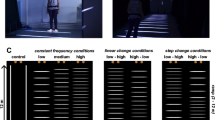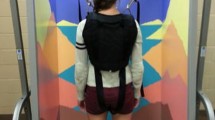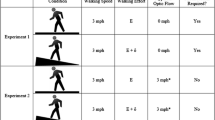Abstract
Three experiments tested the hypothesis that postural sway during locomotion is visually regulated by motion parallax as well as optical expansion. Oscillating displays of three-dimensional scenes were presented to participants walking on a treadmill, while postural sway was recorded. Displays simulated: (a) a cloud, in which parallax and expansion are congruent, (b) a hallway, (c) the side walls of the hallway, (d) a ground surface, (e) a wall, (f) the wall with a central hole, (g) a hall farther from the observer, and (h) a wall farther from the observer. In contrast to previous results with a hallway, responses with the cloud were isotropic and directionally specific. The other displays demonstrated that motion parallax was more effective than simple horizontal flow in eliciting lateral sway. These results are consistent with the hypothesis that adaptive control of sway during walking is based on congruent expansion and parallax in natural environments.
Similar content being viewed by others
References
Andersen GJ, Dyre BP (1989) Spatial orientation from optical flow in the central visual field. Percept Psychophys 45:453–458
Batschelet E (1981) Circular statistics in biology. Academic, New York
Berthoz A, Lacour M, Soechting JF, Vidai PP (1979) The role of vision in the control of posture during linear motion. Prog Brain Res 50: 197–209
Bronstein AM (1986) Suppression of visually evoked postural responses. Exp Brain Res 63: 655–658
Delorme A, Frigon J-Y (1990) Postural adaptation to visual sinusoidal motion. In: Brandt T, Paulus W, Bles W, Dietrich M, Krafczyk S, Straube A (eds) Disorders of posture and gait. Thieme, Stuttgart, pp 261–264
Dijkstra TMH, Gielen CCAM, Melis BJM (1992) Postural responses to stationary and moving scenes as a function of distance to the scene. Hum Mov Sci 11: 195–203
Dijkstra TMH, Schöner G, Gielen CCAM (1994) Temporal stability of the action-perception cycle for postural control in a moving visual environment. Exp Brain Res 97: 477–486
Ferrigno G, Pedotti A (1985) ELITE: a digital dedicated hardware system for movement analysis via real time TV-signal processing. IEEE Trans Biomed Eng 32: 943–950
Gibson JI (1950) The perception of the visual world. Houghton Mifflin, Boston
Gibson JJ (1979) The ecological approach to visual perception. Houghton Mifflin, Boston
Lee DN, Lishman R (1975) Visual proprioceptive control of stance. J Hum Mov Stud 1: 87–95
Lestienne F, Soechting J, Berthoz A (1977) Postural readjustments induced by linear motion of visual scenes. Exp Brain Res 28: 363–384
Longuet-Higgins HC, Prazdny K (1980) The interpretation of a moving retinal image. Proc R Soc Lond [Biol] 208: 385–397
Paulus W, Straube A, Krafczyk S, Brandt T (1989) Differential effects of retinal target displacement changing size and changing disparity in the control of anterior/posterior and lateral body sway. Exp Brain Res 78: 243–252
Rieger JH, Lawton DT (1985) Processing differential image motion. J Opt Soc Am [A] 2: 354–360
Schöner G (1991) Dynamic theory of perception-action patterns: the “moving room” paradigm. Biol Cybern 64: 455–462
Stoffregen TA (1985) Flow structure versus retinal location in the optical control of stance. J Exp Psychol Hum Percept Perform 11: 554–565
Van Asten WNJC, Gielen CCAM, Denier van der Gon JJD (1988a) Postural adjustments induced by simulated motion of differently structured environments. Exp Brain Res 73: 371–383
Van Asten WNJC, Gielen CCAM, Denier van der Gon JJD (1988b) Postural movements induced by rotation of visual scenes. J Opt Soc Am [A] 5: 1781–1789
Warren WH (1988) Action modes and laws of control for the visual guidance of action In: Meijer O, Roth K (eds) Movement behavior: the motor-action controversy. North Holland, Amsterdam, pp 339–380
Warren WH (1995) Self-motion: visual perception and visual control. In: Epstein W, Rogers SJ (eds) Perception of space and motion. (Handbook of perception and cognition) Academic, Orlando, pp 263–325
Warren WH, Kay BA, Yilmaz EH (1996) Visual control of posture during walking: functional specificity. J Exp Psychol Hum Percept Perform
Wheeler S, Watson GS (1964) A distribution-free two-sample test on a circle. Biometrics 51: 256–257
Author information
Authors and Affiliations
Rights and permissions
About this article
Cite this article
Bardy, B.G., Warren, W.H. & Kay, B.A. Motion parallax is used to control postural sway during walking. Exp Brain Res 111, 271–282 (1996). https://doi.org/10.1007/BF00227304
Received:
Accepted:
Issue Date:
DOI: https://doi.org/10.1007/BF00227304




